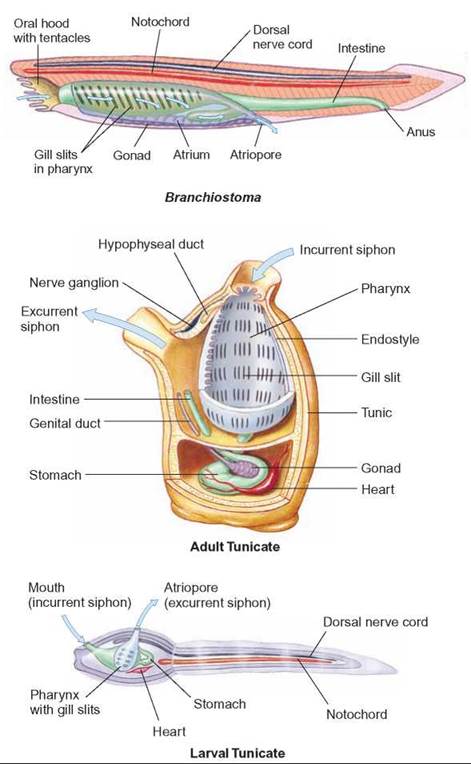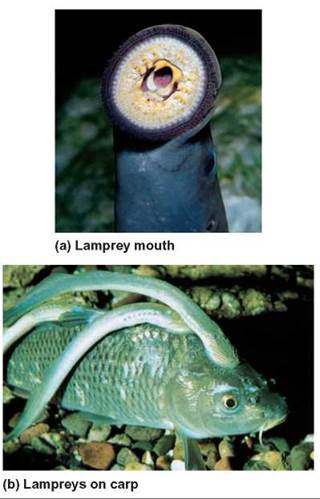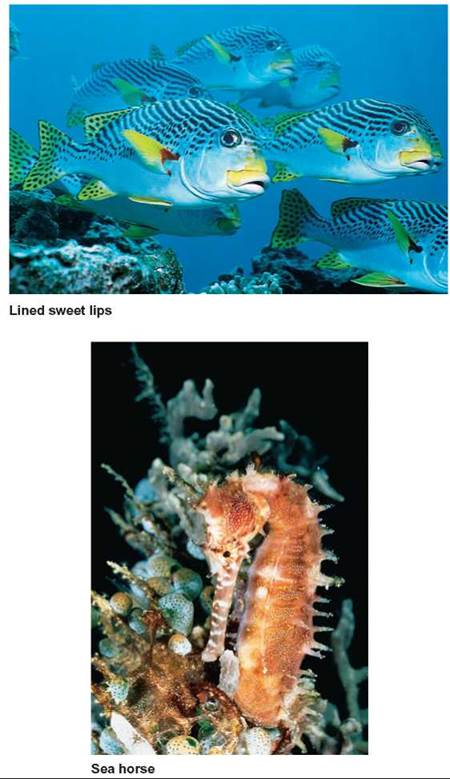CONCEPTS IN BIOLOGY
PART V. THE ORIGIN AND CLASSIFICATION OF LIFE
23. The Animal Kingdom
23.13. Chordata
The chordates are a diverse group of animals. They have a hollow nerve cord down the back of the body; they have a flexible rod just below the nerve cord, known as the notochord; they have a tail, which extends beyond the anus; and they have a region posterior to the mouth, known as a pharynx, that has pouches in it. The most primitive chordates are small marine organisms that have a notochord but no backbone. They are Branchiostoma (formerly named Amphioxus) and tunicates. Branchiostoma has a notochord as an adult, but the tunicates have only a notochord in the tail region during the larval stage (figure 23.27). However, most chordates are vertebrates (animals with a backbone) and only have a notochord during their embryonic stages. In the aquatic chordates the pouches in the pharynx region form gill slits. In terrestrial vertebrates, these pouches are obvious in embryos but are highly modified in the adults.

FIGURE 23.27. Invertebrate Chordates
Branchiostoma and tunicates are invertebrate chordates. They have a notochord but no backbone of vertebrae. Tunicates have a larval stage that has a notochord in the tail. Most tunicates change into a saclike body form that is sessile. Branchiostoma lives in the sand on the ocean floor. Both organisms are filter feeders.
There are several kinds of vertebrates that have always been aquatic organisms and are commonly called fishes. Hagfish and lampreys lack jaws and are the most primitive of the fish. Hagfish are strictly marine forms and are scavengers; lampreys are mainly marine but can also be found in freshwater (figure 23.28). Adult lampreys suck blood from their larger fish hosts. Lampreys reproduce in freshwater streams, where the eggs develop into filter-feeding larvae. After several years, the larvae change to adults and migrate to open water.

FIGURE 23.28. The Lamprey
The lamprey uses its round mouth (a) to attach to a fish and then (b) to suck blood from the fish.
Sharks and rays are marine animals that have an internal skeleton made entirely of cartilage (figure 23.29). These animals have no swim bladder to adjust their body density in order to maintain their position in the water; therefore, they must constantly swim or they will sink. Rays feed by gliding along the bottom and dredging up food, usually invertebrates. Sharks are predatory and feed primarily on other fish. They travel great distances in search of food. Most species of sharks grow no longer than a meter. The whale shark, the largest, grows to 16 meters, but it is strictly a filter feeder.

FIGURE 23.29. Cartilaginous Fish
Although (a) sharks and (b) rays are large animals, they do not have bones; their skeletal system is made entirely of cartilage.
The bony fish are the class most familiar to us (figure 23.30). Their skeleton is composed of bone. Most species have a swim bladder and can regulate the amount of gas in the bladder to control their density. Thus, the fish can remain at a given level in the water without expending large amounts of energy. Bony fish are found in marine and freshwater habitats, and some, such as salmon, can live in both. There are many kinds of bony fish. Some are bottom-dwelling, whereas others are wide-ranging in the open water. Some fish are highly territorial and remain in a small area their entire lives. Of the many kinds, some feed primarily on algae and detritus. However, many are predators.
The remaining groups of vertebrates (amphibians, reptiles, birds, and mammals) all are terrestrial animals. The amphibians are transitional organisms, which must return to water to reproduce and have aquatic larval stages. Reptiles, birds, and mammals have become very successful terrestrial animals. They are discussed in section 23.14.

FIGURE 23.30. Bony Fish
Bony fish have a skeleton composed of bone. Most fish have a streamlined body and are strong swimmers. A few, such as the sea horse, have unusual body shapes and are relatively sedentary.
23.13. CONCEPT REVIEW
31. List three characteristics shared by all chordates.
32. How does a shark differ from most freshwater fish?